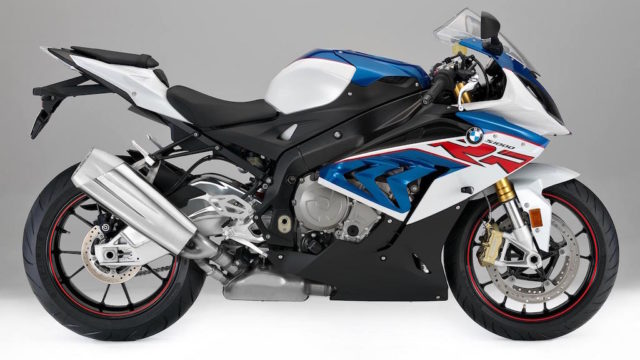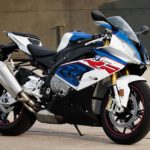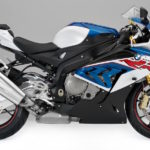Overall Ratings ★★★★★
| Ride: | ★★★★★ |
| Look: | ★★★★★ |
| Value for money: | ★★★★★ |
In a Nutshell
The gas powered German missile
The BMW Motorrad superbike was a total hit since it was launched back in 2009. For many, the S1000RR remains the benchmark in the superbike segment thanks to the immense amount of power and its commuting abilities. The engine sounds like no other and, when you roll the gas, the aggressive acceleration hits you like a punch. The 2017 model received some minor updates to make it Euro 4 compliant and, the electronics package was refined. The asymmetric looks are bearly changed but, the S1000RR seems a bit more powerful and lighter.
What We Liked
The in-line four masterpiece produces around 199 hp (146 kW) at around 13.500 rpm and a maximum torque of 113 Nm at 10.500 rpm. The real power kicks in when you get it to run higher in the rev-range. When the engine revs over 9.000 rpm, and you put it on slick mode the bike lifts the nose like it wants to take-off. The unique engine sound offers a different feeling that will make you fall in love every time you pull the gas.
When it comes to handling, the BMW S1000RR feels robust and stuck to the asphalt. If you don’t have the muscle, it feels hard to steer, but this problem can be solved with a set of lighter wheels that BMW offers optionally. The position is a bit more relaxed compared to other Japanese superbikes, and you can indulge a back pain in favor of the adrenaline rush. The turning angle is not ideal for the city, but with a bit of experience, you can use it as a daily commuter.
When it comes to electronics, the German manufacturer equipped the S1000RR with everything you ever wished for. BMW was one of the first manufacturers to fit their bikes with ABS and Traction Control. The latest S1000RR features a Quickshifter, Riding modes, Launch Control, and ABS cornering as standard. Optionally you can add an auto blipper that works flawlessly, semi-active suspensions, heated grips and even cruise control. In full-spec, the S1000RR is the bike to have when it comes to safety and everyday use.
The BMW S1000RR comes with two impressive features, the engine power, and the electronics. The power is modulated with the help of riding modes making it ideal for every type of rider. The electronics can be adjusted to the smallest details to suit even the most demanding tastes. With these two highlights, the S1000RR is a top superbike when it comes to on-track performance.
The BMW S1000RR is a proper race machine. The fuel consumption is not something to consider when buying this type of bike.
The riding position is very engaging as for a proper sports bike. It can suit taller riders offering enough legs room. The gas tank comes with the right proportions for racetrack use allowing the rider to hang-off like a GP rider.
The stock suspension damping allows you to ride it in a sporty manner and it can handle competitions and track-days. The semi-active suspension adjusts itself according to the riding mode making the bike a bit more predictable and easy to ride. Although the electronic suspension is not ideal for track-use, it can handle a sporty pace if well adjusted.
The build quality is always top notch when it comes to BMW Motorrad. The paint job is always flawless, and the fairings bond together like puzzle pieces. The engine is nicely finished with titanium bolts to reduce weight and, the dash although not TFT or LCD is very easy to work with.
What We Disliked
The only minor thing that we’ve spotted on the S1000RR is the welds on the Euro 4 exhaust that seem a bit rough, but who cares about that.
Raw Data
The base price for the BMW S1000RR is €17,200 (or about $19,145 at the current exchange rate).
BMW offers a wide range of accessories for the BMW S1000RR. You can choose between a full racing exhaust, rear sets, lighter wheels and many more.
| Year introduced | 2017 |
| Max power (horsepower, KW) | 146 kW (199 hp) at 13.500 rpm |
| Max torque (NM, lb-ft) | 113 Nm at 10.500 rpm |
| Top speed (km/h, mph) | Over 180 mph (290 km/h) |
| Engine (CC, CI) | 999 cm³ |
| Frame | Aluminium composite bridge frame |
| Weight (KG, Lbs.) | 208 kg |
| Seat Height (CM, IN”) | 815 mm |
| Front Brake | Twin disc brake, floating brake disc, 4-piston fixed caliper, diameter 320 mm |
| Rear Brake | Single disc brake, single piston floating caliper, diameter 220 mm |
| Front Tire Size | 120/70 R17 |
| Rear Tire Size | 190/55 R17 |
| Front suspension | Upside-down telescopic fork Ø 46 mm |
| Rear suspension | shock absorber |
| Fuel Tank (L, Gal) | 17.5 l |
| Avg. fuel consumption (L/100 KM, MPG | 7 L / 100 km |
| Safety | ABS, Riding modes, Abs cornering, DTC, etc. |
| Price (EUR, USD) | 17,200€ ( $ 19,145 ) |


